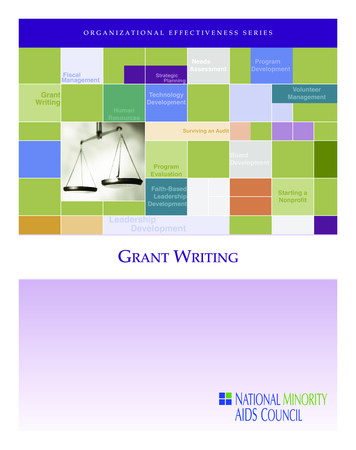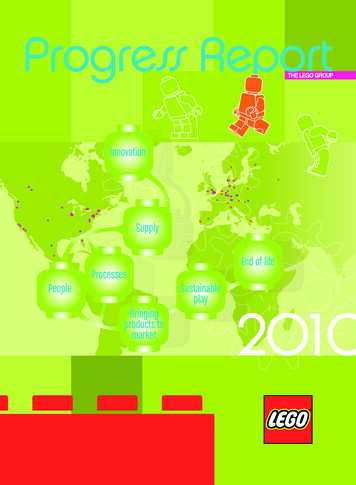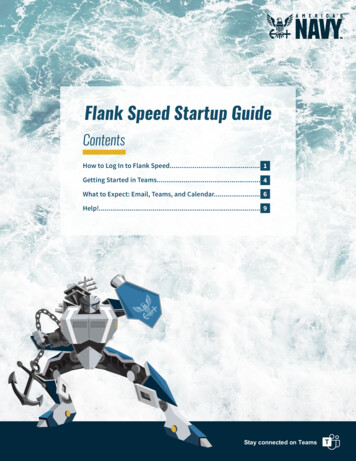
Transcription
81927 NMAC cvr 8/12/03 7:59 AM Page 1ORGANIZATIONAL EFFECTIVENESS entTechnologyDevelopmentHumanResourcesSurviving an eadershipDevelopmentLeadershipDevelopmentGRANT WRITINGStarting aNonprofit
81927 NMAC txt 8/12/03 8:06 AM Page 1Dear Colleague,On behalf of the National Minority AIDS Council (NMAC), thank you for picking up thismanual and taking a step toward increasing your capacity in this struggle. As we enterthe third decade of HIV/AIDS, it is more important than ever to develop our skills andknowledge to better serve our communities and our constituents.NMAC, established in 1987 as the premier national organization dedicated to developingleadership within communities of color to address the challenge of HIV/AIDS, works toproactively produce and provide skills-building tools for our community. One such tool isthe manual that you hold in your hands.The Technical Assistance, Training and Treatment Division’s mission to build the capacityand strength of community-based organizations, community planning groups for HIVprevention and health departments throughout the United States and its territories issupported through a multifaceted approach. This approach includes individualized capacitybuilding assistance, written information (manuals, publications and information providedthrough NMAC’s website and broadcast e-mail messages) and interactive learning experiences (trainings). All components are integral to providing a comprehensive capacitybuilding assistance experience, as opposed to offering isolated instances or randomepisodes of assistance.After undergoing a revision of existing curricula and publications and an expansion ofour current catalog of subject areas to include more organization infrastructure topics,NMAC is proud to present you with this new manual, Grant Writing. One of 15 topic areasin which we provide capacity-building assistance, this manual will provide you withdetailed information, resources and the knowledge to enhance your capacity to providemuch-needed services in your community.Our hope is that this revised manual will give you the skills and knowledge to increase yourcapacity and serve your community at a greater level than ever before. Please feel free tocontact us if you would like further information on other services we can provide to youand your community.Yours in the struggle,Paul Akio KawataExecutive Director1
81927 NMAC txt 8/12/03 8:06 AM Page 3ContentsPreface .5Introduction .7UNIT 1: Introduction to Grant Writing .11I.II.III.IV.V.Private Sector and Public Sector Funding .13The Importance of Planning and Research .14Identifying and Selecting Potential Funders .16Itemizing Needs for Grant Preparation .19Organizing a Proposal Development Team .19UNIT 2: Writing the Grant Proposal .25I. Use Clear, Simple Language .27II. Preparing a Letter of Inquiry .27III. Logical Structure and Elements of a Proposal .29UNIT 3: Developing Prevention Programs .45I. Trends in Target Groups/Priority Populations .47II. Resources for Collecting Relevant Demographic Statistics .48III. Identifying and Selecting Science-Based Interventions .50UNIT 4: Developing a Staffing Plan and Proposal Budget .53I. Key Characteristics of a Staffing Plan .55II. Developing Proposal Project Budgets .58III. Other Frequently Required Financial Information .62UNIT 5: Finalizing and Submitting the Grant Proposal .65I. Conduct an Internal Quality Control Review of the Proposal .67II. Conducting Proposal Debriefings .69UNIT 6: Resource Development .71I. Fund Development Planning .73II. Resources for Conducting Research on Available Grants .75III. Resources to Expand Knowledge and Skills in Grant Writing .783
81927 NMAC txt 8/12/03 8:06 AM Page 4Post-training Assessment.79Appendix A: Glossary .81Appendix B: Annotated Resources .854
81927 NMAC txt 8/12/03 8:06 AM Page 5PrefaceOrganizational EffectivenessSuccessful community-based organizations (CBOs) can attribute their success toemploying 15 key components that support organizational effectiveness. See themodel below.Ongoing learning and training in each of these areas will allow your organization tomeet the needs of your constituents.For information regarding training in any of these areas, contact the National MinorityAIDS Council’s Technical Assistance, Training and Treatment Division by telephone at(202) 234-5120 or by e-mail at ta info@nmac.org.ORGANIZATIONAL EFFECTIVENESS MODELOrganizationalEffectivenessBoard DevelopmentFaith-Based Leadership DevelopmentFiscal ManagementGrant WritingHIV Prevention Community PlanningHuman ResourcesLeadership DevelopmentNeeds AssessmentProgram DevelopmentProgram EvaluationStarting a NonprofitStrategic PlanningSurviving an AuditTechnology DevelopmentVolunteer Management5
81927 NMAC txt 8/12/03 8:06 AM Page 7IntroductionPurposeFor nonprofit organizations, starting or expanding a program is likely to involve submittinga grant proposal to a potential funder as part of a competitive process. This manual willpresent the fundamentals of preparing a successful grant proposal for securing funds fromprivate sources — such as foundations and corporations — and from public sources — suchas federal, state and local governmental agencies. This information is for individuals withvarying levels of experience in grant writing, with an emphasis on government grant application requirements.Learning ObjectivesUpon completion of this manual, learners will be able to: Describe the importance of planning and research necessary for writing a grantproposal.State the differences between grant proposals for private funding sources and thosefor public funding sources.List and describe the elements of government and foundation grant proposals.develop a staffing plan.Recognize and become familiar with grant proposal budgets.Describe project ideas for potential funding that address the needs of target groupsserved by minority HIV/AIDS community-based organizations (CBOs).Identify available resources for diversifying the organization’s funding base and grantproposal writing.Pre-training AssessmentThe Pre-training Assessment is an opportunity for you to check your knowledge against theinformation that will be addressed in this manual. The correct responses to the assessmentare found in the last unit of the manual.Use this manual as an opportunity to learn new information, to receive feedback on challenges you may be experiencing and to develop a networking system that you can use afteryou have finished reading.7
81927 NMAC txt 8/12/03 8:06 AM Page 8Pre-training AssessmentPlease complete the following lists.1.State the major differences between grant proposals written for private fundingsources (foundations, corporations and individuals) and for public funding sources(government).1.2.2.List five (5) key elements of government and/or foundation grant proposals.1.2.3.4.5.Please circle the following statements True or False.1.TrueFalseFour key criteria for matching project ideas with potentialfunders are: geography, mission or purpose, project type andbudget.2.TrueFalseThe instructions, guidelines and evaluation criteria providedby the funder are of great importance when writing a grantproposal.3.TrueFalseThere is a logical structure to most grant proposals.4.TrueFalseEvery grant proposal, even a minigrant, should include sometype of evaluation component.5.TrueFalseA proposal staffing plan is a clear, detailed plan for managingand staffing a proposed project.6.TrueFalseEditing, proofreading and “polishing” a grant proposal are notas important as the project ideas contained within it.Check answers on page 79, after reading the manual thoroughly.8
81927 NMAC txt 8/12/03 8:06 AM Page 9GrantWritingCheck the PulseThis manual was developed based on feedback from other community-based organizations.The “Check the Pulse” exercise provides you with the opportunity to tailor this workshopto meet your learning needs by identifying and developing your most significant learningobjectives. Consider what would be beneficial to you and to your organization.Exercise 1: Check the PulseThis exercise is an opportunity for you to tailor this manual to meet your needs.Directions: Review the learning objectives for this training.Under “Check the Pulse,” list your learning objectives. Think about what knowledge and skills you would like to acquire during this training.Now, go back and review your learning objectives. Identify your two mostimportant learning objectives and write them below:My two most important learning objectives are:1.2.9
81927 NMAC txt 8/12/03 8:06 AM Page 11UNIT 1:Introduction toGrant WritingPurpose:To establish an understanding of the basic roles and responsibilitiesfor grant writing by: Becoming familiar with both public (government) and private(foundations and corporations) funders. Learning how to do the homework involved in planning a strategy,researching potential funders that will support your project orprogram.Learning Objectives:By the end of this unit, learners will be able to: State the differences between private (foundations and corporations) and government (public sector) proposals. Conduct planning and research essential to preparing and submitting proposals to appropriate potential funders. Use Internet resources to expand capabilities in finding informationand in identifying and selecting funding resources. Organize a proposal development team, including designating aproposal coordinator, to plan, write and submit a winning proposal.
81927 NMAC txt 8/12/03 8:06 AM Page 13I. Private Sector andPublic Sector FundingBefore the writing process begins, a substantial amount of background workmust be completed; its importance cannot be overemphasized. You must knowas much as possible about your target group, the intended project and potentialfunders. You must also make sure that your project matches the interests of aprospective funder.There are many places to search for grants. The two major sources are the privatesector — comprised of foundations and corporations — and the public sector —formed by federal, state and local government sources.Private SectorThe process for preparing grant applications for private sector entities is usuallystraightforward and less complicated than for the public sector. There are more than39,000 active, major grant-making foundations in the United States. According tothe Foundation Grants Index of 1997, more than 1,000 foundations gave more than73,000 grants of 10,000 or more to nonprofit organizations, totaling 6.3 billion.Businesses are other sources of funding. Most corporate entities give grants toorganizations in the geographic areas they do business, especially when there isa link between the proposed project and the company’s business activities. Thereis plenty of money available in the private sector to fund your projects — if youknow where to look for it.Public SectorSeeking grants in the public sector is usually more complicated than in the privatesector. It is helpful if the person completing this type of proposal has some experience with grant proposals pertaining to private sector groups.The federal government is the major source of grant funding in the United States;however, available dollars have been on the decline. States are also sources of funding for community based organizations (CBOs). Money from the federal governmentflows typically through states to local governments or CBOs. State and local governmentsalso have their own sources of funds, such as general revenue, tax revenues and otherspecial-purpose funds.PRIVATE SECTORFUNDINGGrant funds securedfrom a foundation,corporation or otherfor-profit entity.PUBLIC SECTORFUNDINGGrant funds securedfrom federal, state orlocal governmentalsource.PROJECTA planned undertakingor organized set ofservices designed toachieve specific outcomes that begin andend within the grantperiod (a successfulproject may become anongoing program).GRANTAn award of fundsmade to an organization as a result of anapproved proposal.13
81927 NMAC txt 8/12/03 8:06 AM Page 14FUNDER(OR FUNDING SOURCE)A private or publicsector organizationthat accepts and reviews grant proposals and awardsmonies to organizations whose grantproposals it approves.Organizations are usually awarded grants as a result of a competitive process. Bothfederal and state grant funds are highly competitive and may involve more work toobtain than private-sector funds. In general, government agencies use a request forproposal (RFP) system. In an RFP, a government entity defines a priority and issuesan RFP that fits the grant-funding priority. Other titles given to requests for fundingapplications are notice of funding availability (NOFA), program announcement (PA)and, less frequently, a request for qualifications (RFQ), which may be used to prequalify a group of applicants with special skills or expertise. These notices appearin the Federal Register, similar state publications and a host of catalogs and registers by topic.REQUEST FORPROPOSAL (RFP)A notice or documentissued by the federalgovernment announcing opportunities to befunded. These noticesappear in the FederalRegister, similar statepublications, and ahost of catalogs andregisters by topic.GRANT APPLICATION(ALSO CALLED GRANTPROPOSAL)An official document orset of documents submitted to a potentialfunder for the purposeof obtaining funds.II. The Importance of Planningand ResearchGrant proposal writing is the act of preparing a grant application for submission to apotential funding source. You can master the process — no matter what your previouslevel of grant-writing skill or experience — if you take the time to study and understand it and tailor it to the needs of your particular organization.Just because a funder is accepting proposals does not mean that you should submitone. “Getting grants” should not be an end unto itself. It is more productive to establish a development plan for your organization first and then identify potential fundersand grants that can help you achieve that plan. The secret to managing great ideas liesin basic organizational planning that entails a strategic organizational plan, including adevelopment plan.After you have decided to apply for a grant, you will need to figure out where tolook for it. At this stage, the importance of advance preparation and “doing yourhomework” cannot be overemphasized. There is research to be conducted aboutthe foundation or corporation to which the grant proposal will be submitted. When conducting background research, it is best to follow a three-step process: 14Step 1. Clarify what type of project you want to fund.Step 2. Identify potential funding sources that give grants for the type of project youwant to undertake.Step 3. Find out as much as possible about the organizations to which youmay want to submit a proposal. Keep in mind that it is far better to submitappropriate grant proposals to a limited number of potential funders than tosend out proposals “shotgun style” to numerous funding sources.
81927 NMAC txt blcx 8/14/03 2:59 PM Page 15GrantWritingMajor Differences Between Privateand Public-Sector Grant ProposalsPrivate-Sector Proposals: Are relatively short.Are relatively uncomplicated.May be developed using an letter of inquiry (LOI) or otherabbreviated format.Public-Sector Proposals: Are lengthier.Are more complex and detailed.Are written in response to an RFP or NOFA.Find out if your organization has ever tried to do something similar, what the resultswere and whether your project could improve upon any previous attempt. Think aboutwhether the project is innovative or has an interesting component that could make itbeneficial to others in the field if the results were made known. Ask yourself if thereare other organizations within your community that would be interested in this type ofwork and whether they might become potential partners for your proposal.For the sake of generating new ideas, it is important to solicit others within yourorganization. Proposal writers can also obtain project ideas by reading journals ornewsletters related to their organization’s mission and by networking with colleaguesabout topics, service delivery models and approaches. Brainstorming and clarifyingproject ideas with the target population by holding focus groups or conducting surveys are invaluable. Also, involving stakeholders — e.g., representatives of the targetpopulation, staff members of potential partner and collaborating organizations, community leaders active in the focus area — can add to the proposal concept and helppromote community acceptance of your project once the grant is won.It will be critical, once the writing process begins, to present a sound case as to whythe project you have in mind is needed. Therefore, you should have hard evidence toprove that there is a significant need or problem and that your proposed project willanswer the need, solve the problem and benefit your target client population. In thisregard, the value of statistical information cannot be overemphasized.NEEDS ASSESSMENTA systematic appraisalof the available servicesand/or gaps in serviceswithin a defined community at a particularpoint in time.GRANT PROPOSALThe end product of thegrant-writing process.REVENUEThe money that willpay for the costs of aproject. In a grant proposal, revenues areusually projected or estimated.LETTER OF INQUIRY(LOI)An initial approach to afunder. Sometimes theLOI is the only document sent to a funder;sometimes it precedesa full proposal.NOTIFICATION OFFUNDING AVAILABILITY(NOFA)The announcementthat a funding programis open. It includesinformation on area ofinterest and eligibility.If your organization has not already conducted a needs assessment, it is time to considerdoing so. A needs assessment is a systematic appraisal of the available services and/or gaps inservices within a defined community at a particular point in time. Needs assessments can be15
81927 NMAC txt 8/12/03 8:06 AM Page 16GRANT PROPOSALWRITINGThe act of preparingan application fora grant to be submitted to a potentialfunding source.broad (looking at all HIV/AIDS-related services for all members of a community) or narrow (looking at members of a specific target population and their complete HIV/AIDSrelated needs) in scope. You will need to identify the existing gaps in HIV/AIDS-relatedservices for the target audience and justify the course of action and methods the projectproposes to implement. Because the HIV/AIDS funding network is highly structured andwell organized, each community and state must perform a needs assessment on a regular basis and publish a prevention plan. This information, along with your own assessment, will be the basis for your proposal’s Statement of Need. More information onconducting a needs assessment is included in Unit 2.Example: You might notice a trend in your homebound clients who are living withAIDS (e.g., a high percentage of clients are suffering from nutritional deficiencies).You would then try to identify why this is happening. Perhaps you learn that clientsare not receiving healthy meals. Then you would look at organizations in your community that provide meal delivery to people living with AIDS. Perhaps you wouldfind that there is a food bank that makes some deliveries, but not in the area wheremost of your clients live. Hence, you have found a need that is not being met. Youmay decide that your organization should start its own food delivery service or try tofind funding to assist the agency providing some delivered meals so that it can expand its geographic area of service.III. Identifying and SelectingPotential FundersThere are many resources available for identifying public and/or private funding sources.Private SectorThe Internet is an invaluable tool for finding grant funds. Keep in mind, however, that manyprivate sector funding sources do not have websites. So, do not limit your search to theInternet. Other good resources are directories, databases, publications (books, newsletters)and broadcast e-mail messages. Networking is also an excellent tool. It is also worth yourwhile to ask board members and colleagues from CBOs similar to yours about grant writingand foundations. They can clue you in to their experiences with particular foundations andhelp you clarify your project ideas.16
81927 NMAC txt 8/12/03 8:06 AM Page 17GrantWritingPublic SectorAll government funders have websites or Internet connections. It is in your best interest to go to these sites on a regular basis (save them in your favorites or bookmarkfolder). The public sector is organized into the same levels as the U.S. government (bygeography and jurisdiction): federal, state and local (including county and/or regional). It is particularly important to stay abreast of local and state funding becauseboth levels are sources of HIV/AIDS prevention and treatment funding and each levelhas an HIV/AIDS bureau or office that distributes Ryan White funds.Participate on local and state advisory committees and on planning councils to stayahead of funding opportunities as well as to give input into policies and plans for yourarea. Networking among others in the field may yield unexpected resources for yourorganization.Often, we restrict and limit our resources by only seeking health funds designated forHIV/AIDS. Remember that your target population consists of men, women and children, in groups and as individuals, who have other needs. Search sites for other related government agencies such as the Centers for Disease Control and Prevention(CDC), and the Departments of Health and Human Services, Education, the Interiorand Agriculture (for rural grant opportunities). Some resources that may help youidentify potential funding sources are listed on the next page. Additional resourceswill appear in later sections.It is just as important for you to determine how appropriate an agency is for your project as it is for the funding agency to determine how suitable your project is for its programs. There are several places to locate detailed information on potential fundingsources so that you can make this determination. You can review their websites; request complete lists of projects they have funded, copies of their most recent annualreports and copies of IRS Form 990F (financial data); ask your colleagues about them;or send a letter of inquiry (LOI) (see Unit 2).Many grant seekers agree that four criteria are important in matching appropriatefunding sources to your cause: location, mission, project type and budget. If the funder makes grants in your geographic area, funds organizations and projects similar toyours and funds projects at a level that meets your project and development needs,then it is a good match.DEVELOPMENTAnother term forfundraising that describes the overall actions of raising moneyfor a nonprofit, usuallythrough donations. Development includesraising money fromfoundations, corporations, governmentsources and individuals.DEVELOPMENTPLANNINGThe process of planninghow an organization willraise the necessaryfinancial resources toaccomplish its work.Usually done on anannual basis, it is oftenpart of the strategicplanning process.ORGANIZATIONALPLANNINGThe process of planningfor the future of your organization. It is oftendone through a strategic planning process.Organizational planningmay be done on an annual basis or for severalyears at a time.You should contact the prospective funder’s program officer or contact person to discuss your project. (Some foundations are small and have only a part-time staff whereaslarger foundations may have several program officers. The federal government and otheragencies list contact persons on the RFP.) During your discussion, give a brief outline of yourproject; find out if your project and the prospective funder’s programs are good matches.(The feedback can be a valuable source of information because the program officer willoften suggest ways to more effectively present your proposal to increase its chance of beingfunded.) The program officer can tell you if your project is wrong for the foundation oragency, thus, saving you valuable preparation and writing time. Summarize the results ofyour background research in an organized manner.17
81927 NMAC txt 8/12/03 8:06 AM Page 18Funding ResourcesPrivate Sector Funding ResourcesThe Foundation Center Directory is published by the Foundation Center. It isavailable for use at Foundation Center Libraries and Cooperating Collections andcomes in both print and electronic editions. If your organization can afford it, signup for the “Foundation Directory On-Line.” This Internet-based directory gives youaccess to thousands of funder records along with direct links to funders’ websites.Go to http://www.foundationcenter.org or call 800-424-9836.The National Directory of Corporate Giving is also published by the FoundationCenter. This print directory provides data on more than 3,300 corporate foundationsand direct-giving programs. It can be used at the Foundation Center Library andCooperating Collections or ordered directly from the Foundation Center. Go tohttp://www.fdncenter.org/marketplace/catalog or call 800-424-9836.GuideStar is an online database of nonprofit organizations. You can go toGuideStar’s website and complete a profile about your organization that funderscan use to access information about your organization. The website also providesgeneral information on nonprofit management and fundraising. Go tohttp://www.guidestar.org.The Council on Foundations Publications Catalog is published by the Council onFoundations, a nonprofit membership organization of grant-making foundations andcorporations that publishes a variety of funding guides. You can read about them inthe “Publications” section of the Council’s website at .cfm or contact them by calling 888-239-5221.Public Sector Funding ResourcesThe Catalog of Federal Domestic Assistance is compiled by the U.S. General Services Administration. This resource profiles all federal grant programs and providescontact information for each one. You can search it for free athttp://www.gsa.gov/fdac.The Federal Register is the official record for all federal programs. Regulations thatall federal programs, and organizations that win federal grants, must adhere to arefound here. Available free at http://www.access.gpo.gov/nara, it is also available in aprint edition and on microfiche (these are not free) by calling 202-512-1800. You mayalso be able to view print copies at your local library.FedWorld.gov is a gateway to government information. You can use the website’ssearch feature to locate information on government grants and funding opportunities. Go to http://www.fedworld.gov.18
81927 NMAC txt 8/12/03 8:06 AM Page 19GrantWritingThe Commerce Business Daily is a resource for federal contracts that lists notices ofproposed government procurement actions, contract awards, sales of governmentproperty and other procurement information. Each edition contains approximately500–1,000 notices. You can search it free at http://www.cbdnet.access.gpo.gov. To receive a print edition, call 888-293-6498. You may also be able to view print copies atyour local library.IV. Itemizing Needsfor Grant PreparationResources Needed for Proposal Writing People and Organization: Lead writer/coordinator and proposal development teamMoney: To hire outside expertise, as needed, and for other expensesFacilities: Space to assemble portions of proposal in process and to packageEquipment: One or more high-speed computers with word processing and graphicssoftware and Internet access, a copier with sorting capability or access to a commercialcopy vendor (e.g., Kinko’s or Office Depot), an ink-jet or laser printer and a three-holepaper punchMaterials: Notebook binders and plastic tabs, file folders and labels, an adequatesupply of paper (white, 8 1/2” x 11”) and other materials for preparing drafts andorganizing your materials during proposal preparation.V. Organizing aProposal Development TeamEven during the best of economic times, nonprofits may lack the financial resources foradding administrative and support staff. As a result, the individuals responsible for grantwriting are often relied upon to plan and write the proposal in its entirety. However, thebest approach to writing successful proposals is through teamwork.19
81927 NMAC txt 8/12/03 8:06 AM Page 20PROPOSALDEVELOPMENT TEAMA group of individuals(comprised of staffmembers, consultants,partners and
Use this manual as an opportunity to learn new information, to receive feedback on chal-lenges you may be experiencing and to develop a networking system that you can use after you have finished reading. 7 81927_N




